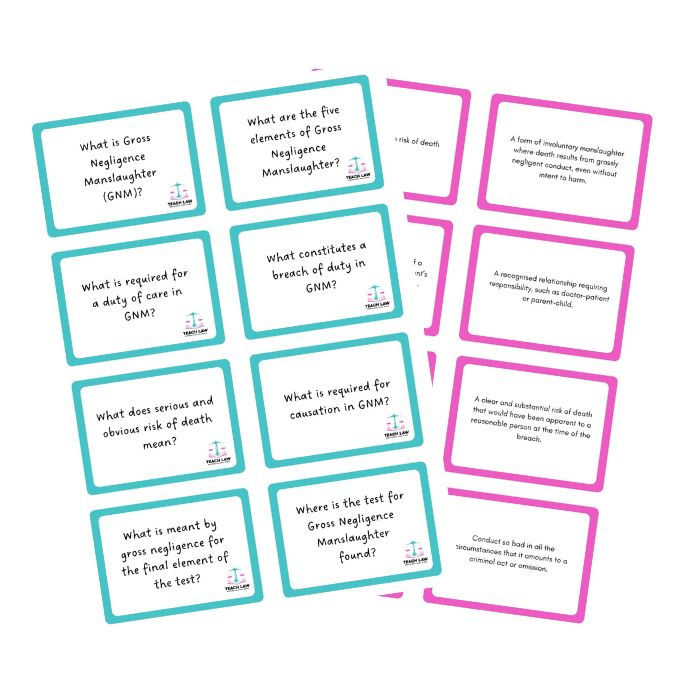Gross Negligence Manslaughter and the Impact of R v Broughton (2020)
- teachlawhub
- May 18
- 3 min read
Updated: Oct 19

Gross Negligence Manslaughter (GNM) is a form of involuntary manslaughter. It applies where death results from a defendant’s grossly negligent conduct, even without any intent to harm. GNM often arises in professional or duty based scenarios where a person fails to act when required to do so, and someone then dies as a result of this.
The 5-Part Test for Gross Negligence Manslaughter
The test for GNM comes from R v Adomako (1995) and has since been updated by cases such as R v Rudling (2016), R v Rose (2017) and reaffirmed in R v Broughton (2020). The test now involves five key elements, all of which must be proven:
Duty of Care - The defendant must owe the victim a duty of care, a duty exists when the defendant is in a position of responsibility or there is a clear relationship that requires them to act (e.g. doctor-patient, parent-child).
Breach of Duty - The defendant must breach their duty, meaning they failed to meet the standard of care expected from a reasonable person in their position. This can be through a negligent act or omission.
Serious and Obvious Risk of Death - At the time of the breach, there must have been a serious and obvious risk of death, not merely of harm or injury. The risk must be one that would have been apparent to a reasonable person in the defendant’s position.
Causation - The breach must cause or significantly contribute to the death beyond reasonable doubt. The normal rules of criminal causation apply (factual, legal, intervening acts.)
Gross Negligence - The breach must be so bad in all the circumstances as to amount to a criminal act or omission. This means the defendant acted so gross as to justify criminal liability.
“Serious and Obvious Risk of Death” in Focus
This third element has become especially important in recent case law. It ensures that criminal liability only arises when the risk is substantial and clear.
R v Rudling (2016)
A GP failed to attend to a sick child who later died from undiagnosed diabetes. The Court of Appeal held there was no “serious and obvious risk of death” at the time of the breach because the GP hadn’t seen the child or received alarming enough symptoms. It was not obvious from the information available that the child was at risk of death.
R v Rose (2017)
Rose was an optometrist who failed to identify swelling behind a boy’s eye, which later caused his death. The Court ruled that the “serious and obvious risk” must be judged based on what the defendant knew or should have known at the time. Since she failed to conduct the examination properly, she could not have known of the risk and could not be criminally liable.
The Impact of R v Broughton (2020)
Facts
At a music festival, Ceon Broughton gave his girlfriend, Louella Fletcher-Michie a drug called 2C-P (a powerful psychedelic drug that can cause seizures, hallucinations and death.) Louella became visibly distressed and displayed erratic behaviour for hours. Despite clear signs she needed help, Broughton failed to call emergency services. He instead filmed her for 6 hours suffering sever reactions including paranoia, confusion and seizures. She eventually died at the scene.
Court of Appeal Decision
Broughton owed a duty of care,
There was a serious and obvious risk of death, and
He breached that duty by failing to seek help.
However, the conviction was quashed because the prosecution could not prove causation beyond reasonable doubt. Medical experts testified that even with early treatment there was only a 10%-30% chance of survival. Therefore, it could not be proved beyond reasonable doubt that his failure to call for help caused the victims death.
Legal Significance
Broughton confirmed the importance of the serious and obvious risk of death as a core part of the test.
It reinforced that causation must be proved to a criminal standard, it is not enough to show that help might have saved the victim.
The case draws a clear line between moral blame and criminal liability.
Download your free TeachLaw student activity sheet with answer key here:

For extra challenge download our free printable GNM Flashcards available here:

For more flashcard packs on other A-Level and BTEC Law topics visit the shop



Comments